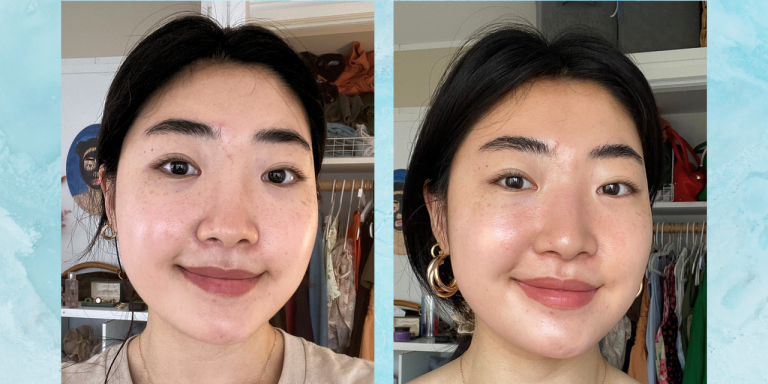
For one, the large, dark pores around my nose and cheeks seemingly disappeared. And that giant angry eyebrow zit I mentioned? It shrunk two days later without leaving a scar, thanks to the painless extraction process. Overall, the HydraFacial left my face feeling moisturized, smooth, and bouncy—not just immediately after, but even a week later! And bonus points for being one of the only professional treatments I’ve tried that didn’t irritate or exacerbate my eczema.
What didn’t the HydraFacial do?
One of my biggest hopes for the HydraFacial was to make my stubborn hyperpigmentation disappear ASAP. To my disappointment, though, the dark spots between my eyebrows were still there (which, to be fair, Vasquez did warn me about beforehand—it can take multiple sessions to see them start to fade, she said).
That being said, I was pleasantly surprised that the one red dot between my eyes did lighten slightly over the next week. Perhaps it was the boost of hydration (because, yes, research shows that moisturizing ingredients can help with mild hyperpigmentation). Or maybe it just took time for the effects of the treatment to show up. Either way, the HydraFacial definitely didn’t make any of my redness and acne scarring worse, which was a relief. (FYI: Vasquez suggests a chemical peel, laser treatments, or micro-needling when it comes to deep and persistent postinflammatory erythema (PIE) and postinflammatory hyperpigmentation (PIH), specifically.)
Is the HydraFacial worth it?
Now, for the three-hundred-dollar question: Do I think you should try it, too? It depends on what you’re looking for. Personally, I can’t speak about how well the HydraFacial works for active acne, say, or icepick scars (Vasquez says it can help with these issues, especially after a few sessions, but I wasn’t dealing with any of that at the time). If you’re looking for a long-lasting glow (like me), however, I’d say it’s worth the *occasional* splurge if you can swing it. As in, a few times a year—maybe before a wedding or once during the hot summer months when your skin is super oily, congested, and feeling yucky from all that sweating—rather than every four to six weeks, which is the standard recommendation. If you are considering the HydraFacial before a major event, though, just make sure to get an appointment two or three days in advance (I saw the biggest difference after three days, and your face can be slightly red and inflamed the day of).
“Even after one treatment, you can typically see immediate improvements,” Vasquez says. “Of course, multiple sessions can help address specific concerns over time, such as improving acne and promoting overall skin health.” It may help to think of the HydraFacial as a tune-up: Rather than some miracle worker, it’s more of a “refresh” to rejuvenate your face—and if you’re like me, your mood—every once in a while.
Related: